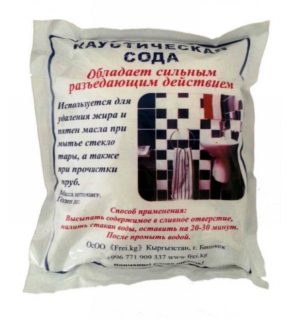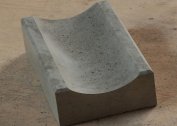Various chemicals are used to clean the sewer. Finished products in bright packaging are expensive, and their effectiveness is not always high. To get rid of blockages, use a proven budget tool - caustic soda. In addition, in the composition of advertised drugs, this substance is usually one of the main ones.
Useful properties for use in the sewer system
 Sodium hydroxide, also called caustic soda or caustic soda, is one of the strongest alkaline substances. It looks like whitish irregularly shaped plates. From the "scales" of the substance, powder, granules, gel and aqueous solution are created and these compositions are used to clean sewer lines.
Sodium hydroxide, also called caustic soda or caustic soda, is one of the strongest alkaline substances. It looks like whitish irregularly shaped plates. From the "scales" of the substance, powder, granules, gel and aqueous solution are created and these compositions are used to clean sewer lines.
The use of caustic as a cleaning agent is based on the following qualities:
- destructive effect on fatty compounds;
- reduction of organics to decay;
- disinfecting effect.
This substance must be distinguished from ordinary baking soda and calcined. They are also used to clean pipes, but in case of small blockages. All three compounds are alkalis, but caustic soda is more caustic and effective.
Pros and cons of cleaning the pipeline with caustic
 The advantages of using caustic soda for cleaning sewage elements are based not only on the destructive properties of a substance that can dissolve clogging and remove plaque. Additional advantages are:
The advantages of using caustic soda for cleaning sewage elements are based not only on the destructive properties of a substance that can dissolve clogging and remove plaque. Additional advantages are:
- smoothing irregularities on the inner surfaces of the pipe segments, which prevents the appearance of deposits;
- exposure duration - the reaction also occurs after flushing;
- low cost.
As a prevention, it is enough to carry out one cleaning every 30 days.
A feature of the use of sodium hydroxide is that it is used to clean the sewer in residential buildings and in factories - to clean pipelines and boilers. It is also often used after a cleansing effect with acidic means to restore balance and keep the pipe surface intact. Additionally, caustic agents are suitable for cleaning main pipelines, including sewer ones, using the “shock wave” method.
Hygroscopicity of a substance has its pros and cons. It is not difficult to prepare a solution of caustic soda, however, soda should be stored in sealed bags so that it is not saturated with moisture.
The disadvantages of the application include the fact that soda is able to destroy the enamel of bathtubs and sinks. It is also difficult for her to remove dirt and earth. Inaccurate use, you can get a chemical burn.
Wastewater treatment methods
Using caustic soda at home is easy. The main thing is to observe the proportions of caustic soda and related components for cleaning the sewer, and not to neglect safety measures.
Solution use
To prepare the solution, you need to dilute caustic soda with water to flush the sewer pipes. The proportions depend on the location and degree of blockage:
- for preventive washing, dilute 2 kg of caustic soda in 4 l of water;
- to clean a clogged sink, you will need 150 g of alkali and two glasses of boiling water;
- a small blockage is eliminated with a solution of half a glass of soda in 3 liters of water;
- cleaning a heavily clogged runoff is carried out with a composition of 4 kg of soda and 7 liters of water.
The technology of the procedure is similar for all cases. The composition is poured into the right place of the highway, left for an hour, then thoroughly washed with hot water.Additionally, after washing over a clogged pipe, it is worth working as a plunger.
Powder and gel cleaning
 You can also clean the sewer line with a dry composition in the form of powder, granules or plates. The effect will come out no worse than after cleaning with a solution. There are three ways to dry clean:
You can also clean the sewer line with a dry composition in the form of powder, granules or plates. The effect will come out no worse than after cleaning with a solution. There are three ways to dry clean:
- 3 l of hot water is poured into the drain hole, and then 20 g of powder or granular soda is poured. Top pour a glass of cold water and wait three hours. After that, a thorough wash with warm water is carried out.
- 20 ml of vinegar or the same amount of diluted citric acid are poured into the pipeline. Fall asleep 40 g of dry caustic. Substances will react, which will become noticeable when a large amount of foam appears. When it falls off a bit, plug the drain hole with a cork or rag roller. Two hours later, washed with warm water under high pressure.
- Pour 40 g of dry caustic into the toilet. Pour a liter of warm water. After an hour, flush several times. This is the most traumatic for pipes, but the most effective method. It is used for severe blockages in the sewer.
Dry methods are not suitable for cleaning plastic lines. The process will be too active: alkali can corrode the polymer layer.
It is better to clean contaminated polymer pipelines with caustic in the form of a gel - this option is commercially available. Shake 250 ml of gel-like substance and pour into a toilet bowl or sink, pour a couple of liters of hot water. After two hours, rinse with cold water. This method is inferior to the previous ones in terms of efficiency, but spares polymer lines.
Use for autonomous sewage
Local sewer networks in private homes are also cleaned with caustic soda. To do this, follow the instructions below:
- Dissolve 3 kg of dry caustic in 7 l of cool water and stir with a plastic spatula. Due to the interaction of substances, the composition will begin to warm up. In a few minutes it will reach 70 degrees.
- When the reaction stops, pour half of the composition into the sewer through any drain hole and leave for three hours. You cannot use the sewer system during this period.
- After the specified time, pour in the remaining half of the composition and wait another three hours.
- Rinse the pipes with cool water under high pressure.
In a similar way, you can clean and disinfect a cesspool in the country. In this case, flushing is also mandatory, especially if a plastic tank is used as a sump.
Precautionary measures
 Caustic soda is called a substance for good reason. If you interact with it incorrectly, you can get severe burns. To prevent trouble from happening, you must follow the safety rules:
Caustic soda is called a substance for good reason. If you interact with it incorrectly, you can get severe burns. To prevent trouble from happening, you must follow the safety rules:
- Wear rubber gloves and goggles so that the substance does not get on the skin and the vapors do not burn your eyes.
- During the reaction, do not breathe air near the container where the soda dissolves. Better yet, wear a respirator.
- Perform cleaning procedures with windows and doors open.
- Take dry soda only with a spoon or spatula.
- Keep the substance in an airtight container in a dry place inaccessible to babies and pets.
If the alkali does get on the skin or mucous membranes, rinse the area thoroughly with water. If possible, treat a skin burn with a weak solution of citric, acetic or two percent boric acid. If the damage is serious and your health is getting worse, you should call for emergency help.
With proper work with caustic soda, you will return the sewerage pipeline to its original passability and save the family budget on advertised expensive cleaners.


